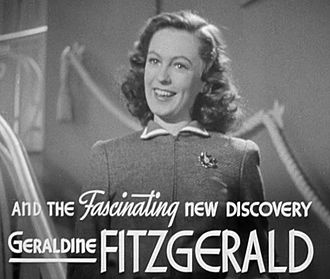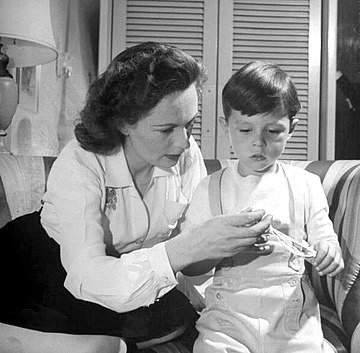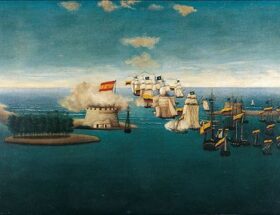
Early Years
Geraldine Fitzgerald wa born on November 24 1913 in Greystones, County Wicklow (south of Dublin) as the daughter of Edith Catherine and Edward Martin FitzGerald, a lawyer.
Geraldine studied painting at the Dublin School of Art. Her aunt, actress Shelagh Richards, inspired her to pursue an acting career and in 1932 she started performing in the Gate Theatre. After two seasons in Dublin she moved to London where she achieved success in British films like The Mill on the Floss, The Turn of the Tide and Cafe Mascot.
Acting Career

In 1938 Fitzgerald’s success led her to the Broadway stage. There she made her American debut opposite Orson Welles in the Mercury Theatre production of Heartbreak House.
Producer Hal B. Wallis saw her in this production and subsequently signed her to a contract with Warner Bros. Two significant successes were made in 1939: a role in the Bette Davis film Dark Victory, and an Academy Award nomination for her supporting performance as Isabella Linton in William Wyler’s Wuthering Heights.
She then appeared in Shining Victory (1941), The Gay Sisters (1942), and Watch on the Rhine (1943) for Warner Bros., and Wilson (1944) for 20th Century Fox, but her career was hampered by her frequent clashes with studio management. Such a case was when she lost the role of villainess Brigid O’Shaughnessy in The Maltese Falcon (1941), after clashes with executive Jack L. Warner.
Although she continued to work throughout the 1940s, co-starring with John Garfield in the Warner Bros. crime drama Nobody Lives Forever (1946), and Between Two Worlds (1944) the quality of her roles began to diminish and her career lost momentum.
In 1946, shortly after completing work on Three Strangers, she took a leave from Hollywood to return to New York City, where she married her second husband, Stuart Scheftel. She returned to Britain to film So Evil My Love (1948), receiving strong reviews for her performance as an alcoholic adultress, and The Late Edwina Black (1951), before returning to the United States.
On April 18 1955, she became a naturalized United States citizen. The 1950s provided her with few opportunities in film, but during the 1960s she asserted herself as a character actor and her career enjoyed a revival.
Among her successful films of this period were Ten North Frederick (1958), The Pawnbroker (1964), and Rachel, Rachel (1968). Her later films included The Mango Tree (1977), for which she received an Australian Film Institute Best Actress nomination, and Harry and Tonto (1974), in a scene opposite Art Carney.
In the comedy Arthur (1981), she portrayed Dudley Moore’s wealthy and eccentric grandmother, even though she was only 22 years older than Moore. In 1983, she portrayed Rose Kennedy in the miniseries Kennedy with Martin Sheen, and co-starred as Joanne Woodward’s mother in the 1985 drama Do You Remember Love. Fitzgerald appeared in the 1983 Rodney Dangerfield comedy Easy Money, the horror film Poltergeist II: The Other Side (1986), and the comedy Arthur 2: On the Rocks (1988). In 1986, she starred alongside Tuesday Weld and River Phoenix in Circle of Violence, a television film about elder abuse.
Fitzgerald returned to stage acting and won acclaim for her performance in the 1971 revival of Long Day’s Journey Into Night. In 1976, she performed as a cabaret singer with the show Streetsongs, which played three successful runs on Broadway and was the subject of a PBS television special. She recorded an album of the show for Ben Bagley’s Painted Smiles label. She also achieved success as a theatre director and in 1982 became one of the first women to receive a Tony Award nomination for Best Direction of a Play for a production of Mass Appeal.
While in New York, she collaborated with playwright and Franciscan brother Jonathan Ringkamp in founding the Everyman Theater of Brooklyn, a street theater company. The company performed throughout the city, including at Ethical Culture and La MaMa Experimental Theatre Club, both in Manhattan. The company first performed at La MaMa in September 1972, with a production called Everyman at La MaMa. They then performed The Francis-Day, a musical about Francis of Assissi, at La MaMa in July 1973.
She also appeared on television, in such series as Alfred Hitchcock Presents, Robert Montgomery Presents, Naked City, St. Elsewhere, The Golden Girls, and Cagney and Lacey. She had a regular role in the short-lived 1965 CBS serial Our Private World.
In 1987, she played a title role in the television pilot Mabel and Max, produced by Barbra Streisand. She received an Emmy Award nomination for a guest role playing Anna in The Golden Girls Mother’s Day episode in 1988, and played a different character in the episode “Not Another Monday”. She subsequently won a Daytime Emmy Award as best actress for her appearance in the NBC Special Treat episode “Rodeo Red and the Runaways”.
On February 8 1960, Fitzgerald was recognized with a star on the Hollywood Walk of Fame, at 6353 Hollywood Boulevard, for her contributions to motion pictures.
Personal Life

On November 18 1936 Geraldine married Sir Edward Lindsay-Hogg in London. By this marriage she had one son, Michael Lindsay-Hogg.
After three years of seperation a divorce was granted to her on August 30 1946. She then went on to marry businessman Stuart Straus Scheftel, whose grandparents Ida and Isidor Straus perished on the Titanic. By her second marriage she bore a daughter, Susan Schefte.
Michael’s resemblance to American actor Orson Wells, a past colleague and lover of Geraldine, led to rumors of him being the biological father. She never confirmed the rumor to her son although her close friend Gloria Vanderbilt claimed Geraldine had told her it was true.
Death
Geraldine, after a long battle with Alzheimer’s disease, died on July 17 2005 in New York City at the age of 91. She was buried in Woodlawn Cemeter, Bronx.

